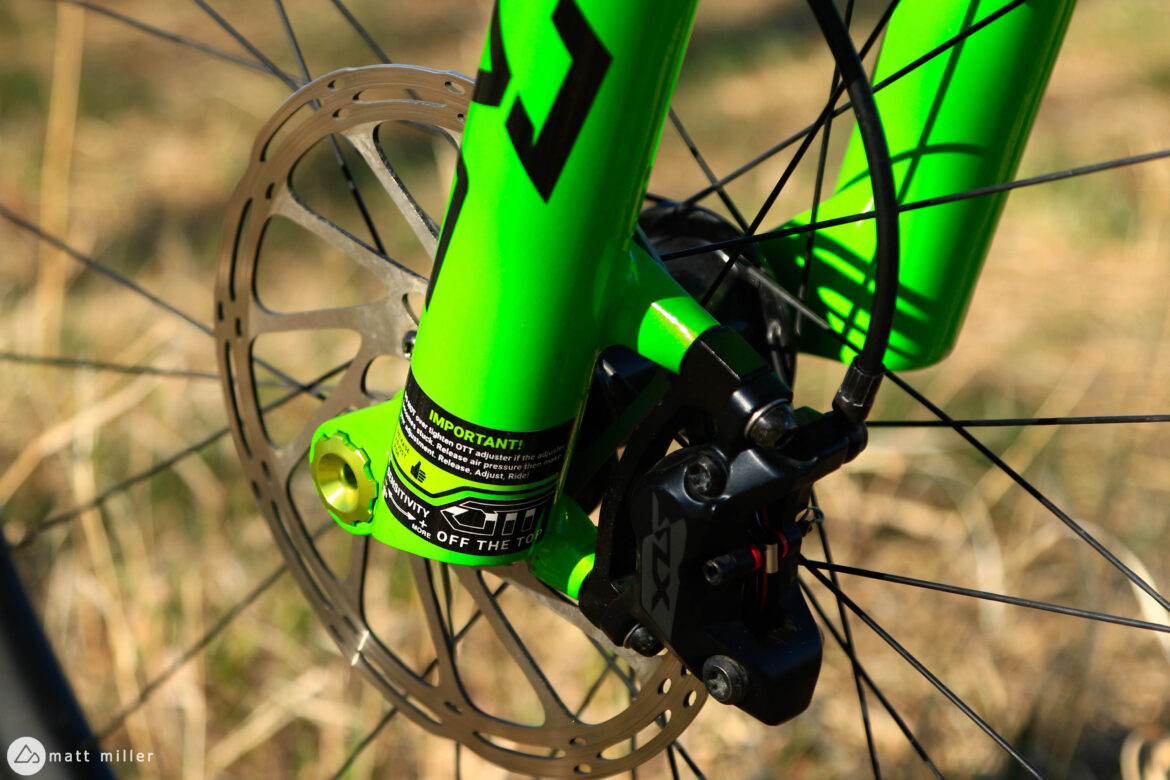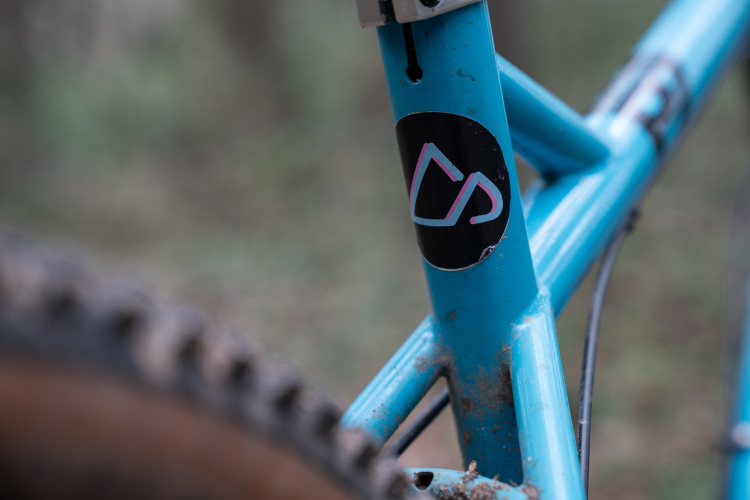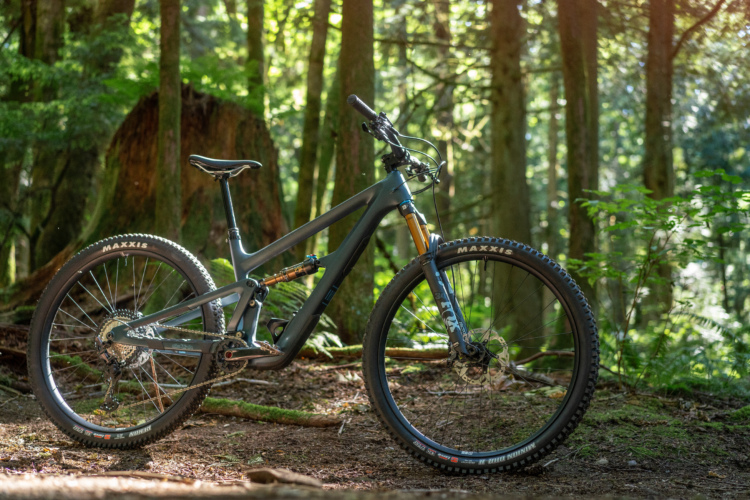
Air-sprung forks can be tricky beasts when it comes to finding the right settings. By nature, air-pressured forks can be challenging to find a proper balance of top-end sensitivity and mid-stroke support. Pumping too much air gives you more support, but at the expense of your small-bump sensitivity and running too little air for improved compliance creates a big soft spot in the middle of your fork travel. There’s a good reason why people will take the added weight of a coil spring for better suspension performance.
I wasn’t sure what to expect when I received the bright Mountain Dew green DVO Sapphire D1 fork several months ago and pulled the very supportive and flashy, but not loud, silver RockShox Pike off of my Ibis Ripley AF.
But I’ve had nothing but good experiences with the DVO Sapphire D1 and it’s not leaving the bow of my bike any time soon.

About the DVO Sapphire D1
The Sapphire is DVO’s trusted trail fork that is on the lighter end compared to the Diamond and the Onyx. It uses 34mm stanchions and comes in 10mm travel increments between 120mm and 140mm for 29ers and 130mm and 150mm for 27.5″ bikes.
Inside the fork, DVO uses a compression bladder damper instead of an internal floating piston, unlike other fork brands. DVO says the bladder is surrounded by oil as it compresses through the stroke which gives the fork generous small-bump sensitivity, consistent damping, and added durability.
The benefits of the bladder also include not just mitigated stiction, but “no stiction,” that little feeling of hangup when you first compress a piece of air suspension.
DVO forks are also known for the ability to adjust top-end sensitivity, and the Sapphire D1 has the OTT (Off the Top) feature to manually adjust how the fork feels in its first moments of travel. It can be adjusted in the garage or trailside with a 5mm hex key, but there is still a range of suggested adjustment. After 30% of travel is achieved, the OTT spring is disengaged, then gets into the positive air spring. The 5mm hex key places a load on a coil negative spring in the fork, adding or relieving pressure.
The point of the OTT feature is that unlike other air forks, you can set your air pressure to control mid-stroke and bottom-out resistance and the top-end sensitivity remains independent.
The Sapphire has six clicks of low speed compression damping, five clicks (full rotations) of high speed compression damping, and 22 clicks of available rebound adjustment.
The fork is only available in reduced offsets, either 42mm for 27.5″ wheels or 44mm for 29ers and it is only available with Boost spacing. Brake rotor mounting is set to accept 160mm rotors from the box. It’s available in either green, blue or black. The Sapphire weighs about 1900g.
The 130mm travel, 29er Sapphire D1 we tested sells for $924.

On the trail
I won’t lie, I was reluctant to don the antifreeze-green fork on the Ripley after I took off the coin-colored Pike, but since I haven’t spent a whole lot of time on DVO suspension before, another part of me shook with excitement.
I started off with DVO’s recommendations via their custom tune. For my ~170lb rider weight, I was at about 90PSI with 20% sag and 13 clicks of rebound with 5 rotations on the OTT. My first ride was at a pretty mellow and buff trail network close to home and the mid-stroke support was immediately noticeable in the fork, but I wasn’t getting too deep into the travel either. Surprisingly, traction was still good.
I dialed back the HSC all of the way and made sure there weren’t any volume spacers in the chamber. This was still a little too progressive, so I took about 5psi out of the fork. I also decreased the rebound by one or two clicks.
My next testing ground for the fork was Palo Duro Canyon in Amarillo, Texas; a pretty sweet state park with a mix of tight, janky, technical trails and some fast, flowy singletrack. With the lower air pressure, the fork started to feel great here, for me. The other noticeable attribute of the fork? People loved the bright green. I can’t totally quantify this, but the amount of “Sweet bike!” comments by hikers definitely increased.
The only change I made after Texas was speeding the rebound back up after I noticed the fork packing up over high speed rocky sections and giving my hands some pain. Funny enough, I had the same experience with a fork on another bike, and speeding up the rebound was a game-changer.
After spending a few months on the Sapphire D1 and toward the end of this review, I settled on some settings I really preferred: 85psi, rebound at 13, and 5 rotations of OTT, and typically running the LSC at 2/6. I ran my HSC almost all the way open.
It’s fairly close to what DVO recommends for me. To be certain, I returned to their recommendations again before writing this, with faster rebound, and an additional rotation of OTT since it’s within my weight recommendation, but I returned to the settings I mentioned above since it felt just about perfect.
What is perfect? For me, it was a really buttery top-end feeling where mid-stroke starts to kick in at about 30-40% of the travel. On fast, rocky trails, the fork would float over chunk and help me keep my speed and support, and I was matching the appropriate amount of travel on bumps and jumps.

Highlights of the DVO Sapphire D1
There are a few things I really liked about the DVO Sapphire D1 trail fork. First, I think it does a great job balancing support with sensitivity and traction and has a unique ride feel compared to RockShox and Fox with less noticeable stiction. The fork feels very active and fast but composed under hard conditions, with the right settings. Like most forks, it can take a while to find the perfect settings for you, even with a custom tune. But once you’re there, you can really focus on just adjusting the LSC for whatever terrain you’re on.
Another bonus for the DVO is that it comes with a bolt-on fender, though it can become a rock scraper at times. And while I wasn’t crazy about the bright green at first, I must admit it’s grown on me quite a bit.
With the right settings though and the OTT feature, I felt like I had one consistent setting for most terrain that used its travel wisely and I relied less on the sweep LSC damper.
What could be better?
There were also a couple nitpicks I had with the Sapphire. Though I’m sure it’s a necessary part of the internal adjustment process, it take some patience to release the air and re-pressurize the air chamber every time you need to adjust the OTT setting. The OTT also only really gives you three recommendations per your air pressure.
The Sapphire D1 is also set up to accept 160mm rotors. Though DVO recommends the fork for both XC and Trail, I imagine true XC riders are going to look for something leaner than the 34mm-stanchioned fork anyway and it would be great to bypass the additional brake adapter on the fork to fit a 180mm rotor.

Pros and cons of the DVO Sapphire D1 mountain bike fork
Pros
- Great traction, support, and tunability
- Unique, stiction-less feel (and look) compared to other forks
- Coil-like performance with a lighter weight
- Included fender
Cons
- Can be tricky to find the right settings
- Most riders will likely need a brake adapter to run 180mm+ rotors
- Slightly heavier than some comparable forks
Bottom line
The DVO Sapphire D1 trail fork is a great air fork for trail riders who want to get the most out of their suspension.
- Price: $924 plus $150 for an optional custom tune.
- Buy from JensonUSA.











3 Comments
Jun 15, 2023
Getting valving right is part of the process that gets overlooked, especially with air sprung suspension.
Jun 15, 2023
I like a stiff setup, even in chunky terrain, and the DVO glides over chatter, is still supple yet supportive in the midstroke, and resists bottom out nicely. I love it and prefer the DVO to the Fox 38 Factory and Pike I have on my other bikes, though those are admittedly great forks, too. DVO will be my go-to fork for builds going forward. The experience led me to buy a shock to try on my Ripmo. Excited to see how that goes.
Jun 15, 2023